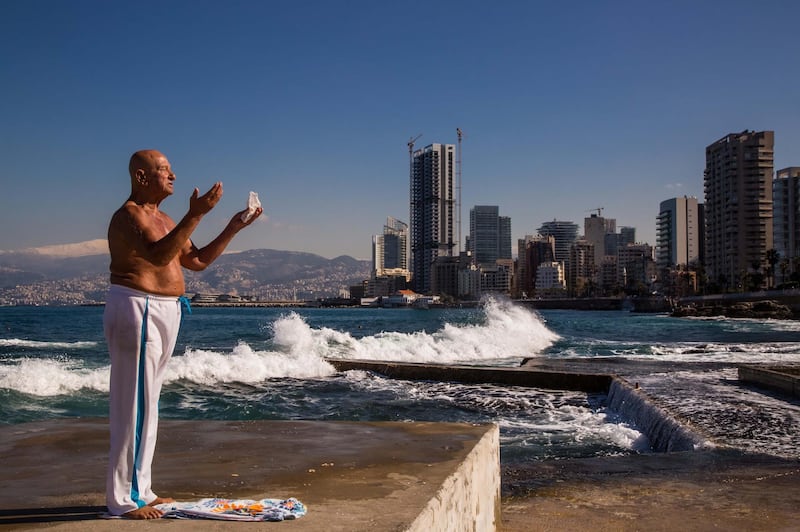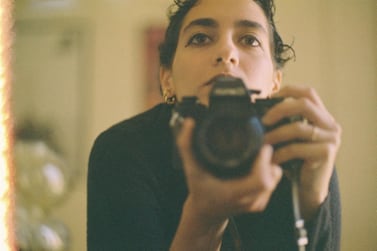In Vianney Le Caer's photographs, the sunbathers who gather at the beach at the American University of Beirut preen and spread themselves like a colony of bronzed seabirds on some off-shore promontory. A concrete carbuncle that juts beyond the Corniche Beirut, the beach may be little more than an outcrop of crumbling walkways and derelict swimming pools, but it fosters its own unique sense of community for an unlikely group of men who can be found there each day, exercising, sunbathing and praying.
A freelance photojournalist who lives in London, Le Caer discovered the beach in 2015 while on an assignment with an NGO in Lebanon, covering the Syrian refugee crisis. Despite covering conflicts in Iraq, Ukraine, Syria and the Democratic Republic of Congo, Le Caer felt anxious about approaching the men, but he was welcomed by a leathery veteran, Abu Khodor, a regular on the beach for 25 years.
A former crane operator in the nearby Port of Beirut, Khodor regaled Le Caer with tales of sunbathing on the beach alone while watching the Israeli air strikes that rained down on Lebanon after eight Israeli soldiers were killed by Hezbollah in 2006.
A 'wake-up call' for political awareness
Le Caer's photographs and the Lebanese-Israeli conflict both play a key role in the exhibition C'est Beyrouth, which opens on Thursday at the Institut des Cultures d'Islam (ICI) in Paris.
The exhibition, which features 16 photographic and video artists whose work has engaged in some way with the Lebanese capital since 2006, has been curated by Sabyl Ghoussoub, a French-Lebanese photographer, writer and columnist who describes himself as a multidisciplinary artist. He served as director of the Lebanese Film Festival in Beirut between 2012 and 2015, and in 2018 published his first novel, the darkly satirical Le Nez Juif.
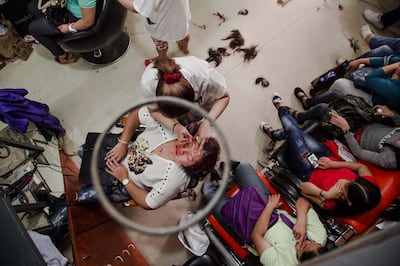
"In a country already weakened by successive attacks on politicians and journalists, this war, usually referred to as the 'July War' or the '33-Day War', broke all the hope that the people felt after the Syrian army left the country in 2005," Ghoussoub says, describing the conflict as a "wake-up call" in terms of his own political awareness. He says the conflict haunts the subconscious of all Lebanese people, regardless of age or religion.
"Bombs were falling on Beirut after 15 years of reconstruction and for the new generation of Lebanese and the immigrants living in the city, it was their very first conflict. For the older generation, it was one more in a long line of wars."
Inside the exhibition
Organised according to themes that investigate the body as a site and symbol of identity, religion, and the experience of marginalised minorities, the show begins with a section called The Spectre of War, which features a video of Fouad El Khoury's autobiographical On War and Love from 2006. Consisting of 33 works arranged chronologically, beginning on July 13 and ending on August 14, On War and Love chronicles life during the Israeli bombardment, a time that became even more traumatic for El Khoury when, three days into the siege, he discovered that his girlfriend was leaving him.
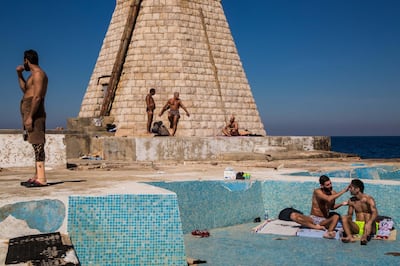
In 2007, On War and Love featured in Lebanon's first national pavilion at the Venice Biennale and was also exhibited in the Roads Were Open / Roads Were Closed group show at Dubai's Third Line Gallery in 2008, where his works were paired with others that explored the links between personal and collective memory, and the perception and experience of conflict-related trauma.
These included Joana Hadjithomas and Khalil Joreige's Wonder Beirut, which retraced the career of Lebanese photographer, Abdallah Farah, who at the start of the Lebanese Civil War in 1975 began to damage the negatives of his postcards in ways that both imitated and documented the ensuing destruction.
Ghoussoub also pairs El Khoury with Hadjithomas and Joreige in C'est Beyrouth by including a video from the Prix Marcel Duchamp-winning duo called Tout Est Vrai. Exhibited in the ICI's hammam, Tout Est Vrai gives voice to the experience of migrants and has been selected as part of C'est Beyrouth's Ignored Minorities strand, alongside photographs from artists such as Myriam Boulos, which explore the exploitation of foreign domestic workers. "Focusing on these minorities was essential to me," Ghoussoub insists. "I think that we can judge the state of a society by how marginalised people are threatened in it and I wanted to show how these people live in a religious city and in a paternalist society."
C’est Beyrouth
For Ghoussoub, the idea for C'est Beyrouth came not from a desire to make a political point but from his need to understand and come to terms with a city in which people's behaviour is often driven by fear. "I lived and worked in Beirut and I have a love and hate relationship with the city," he says. "Two years ago, I left Beirut and moved back to Paris. I was so sure that I could get it out of my mind. A year later, I had to finally admit that I was obsessed."
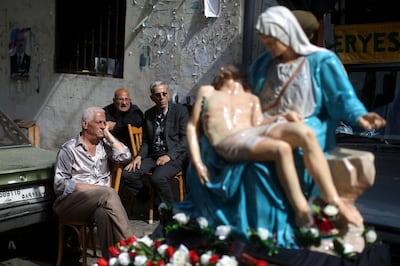
Ghoussoub admits that when it came to curating the exhibition, the hardest task was deciding on a title. But given his relationship with the city, it's perhaps no surprise that he chose a name that is as troubled and ambiguous as the place itself. "C'est Beyrouth, or This is Beirut, is an expression that people both in Lebanon and outside of Lebanon often use to describe a situation of chaos," he explains. "But the title can also be read as an affirmation."
It is a phrase that frustrates certain Lebanese people because they believe it evokes negative connotations and outdated images of the city, such as notions of devastation, chaos and destruction. But the phrase "C'est Beyrouth" also conjures notions of understanding and shared experiences, if not always acceptance.
"These photos and videos are really a way to speak about numerous sensitive subjects and to show certain truths about Beirut's reality," Ghoussoub says. "Beirut doesn't have any lessons to give to other cities in the region, but its experience is unique. It is the city of every contrast and paradox possible."
C’est Beyrouth runs at the Institut des Cultures d’Islam in Paris from Thursday until July 28. Visit www.institut-cultures-islam.org
